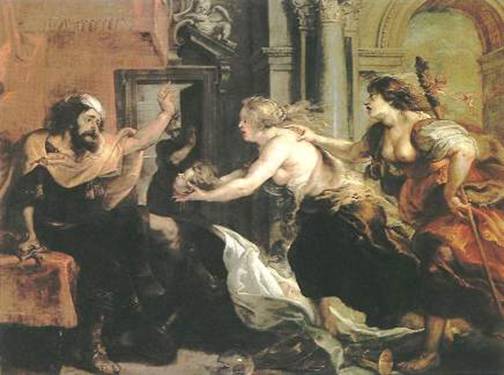


The Banquet of Tereus , by Peter Paul Rubens
The modern day interpretation of the myth of King Tereus, Procne, and Philomela that interests me the most is the painting by the baroque painter Peter Paul Rubens entitled “The Banquet of Tereus.” The painting is of Procne and Philomela presenting Tereus with the head of his son Itys that Procne and Philomela has secretly tricked him into eating. Ovid’s Metamorphoses inspire Rubens oil painting.
The overall tone of the painting is dark, which is appropriate giving the scene depicted. The prominent colors used are more earthy colors, like browns, reds, and blacks. This makes certain things of color stand out more such as Tereus’s golden yellow wrap or Procne’s hair. The area of the painting with the most lighting takes place in the dead center of the painting. The reason being that the tablecloth, and Procne who are both white stand out amongst the dark surrounding. This draws focus to Itys head in Procne’s head. Which is the key point in the painting because it shows the revenge aspect of the myth.The painting does a good job of showing Procne and Philomela in motion. Both of their hair is blowing backwards which would mean they were moving at a fast pace. Also both of their bodies are propelled foreword in an attacking motion. The women are half dressed with their breast exposed. This could be that they were in such a hurry that their dresses got ripped somehow, which would mean the girls have a lot of adrenaline and do not even notice that they are not fully dressed.
All three of them are holding objects in their hands. Procne is holding her son Itys' head in her hands and is presenting it to Tereus. Philomela is holding some type of staff behind her back and concealed from Tereus. This shows that Philomela is ready to attack Tereus if she needs too or that she is planning on attacking him and is just waiting for the right moment. Tereus is holding a sword in his right hand, but it doesn’t look like he is ready to use it. This is probably because he is in so much shock.
Scanning the background we can see a statue of a cherubim located in the uppermost part of the painting. He appears to be holding an arrow, which might lead us to believe that this is cupid. Also located in the background is a mysterious figure in a doorway. It’s not quite clear if it’s a man or a woman, but I think it’s a woman. This is probably one of the servants of King Tereus. The lower front part of the painting is blurry and not clear which is probably because whatever is painted there is not to important. There is an archway in the upper right corner and its not clear if it is a window or some type of painting. And if so it’s not clear what it is.
By looking at this painting we can tell what values that Rubens perhaps was trying to get across. Starting with Tereus we can see the disgust and horror in face when he realizes not that his son is dead, but that he has just eaten him. Tereus looks like he is in shock and has to brace himself against the table. He also has his left hand stretched out in front of him and it seems like he is trying to block the image of his view. This definitely shows that eating another human being, let alone your own children was something that was very appalling.In the painting we see that both Procne and Philomela breasts are exposed. This was an artistic license that Rubens took since in the myth they never say that their breasts were exposed. The significance of this can be social commentary on gender. In this painting the women are the aggressor and getting vengeance on a man. There is a role reversal that can be seen here. One of the girls is carrying a weapon of some kind, and both of them are charging at Tereus. The scene shows the power of women and them taking charge.
The painting does not reveal anything about history or ethnicity in this particular painting. However the characters depicted are all white in their skin tone. Also there are no religious tones that I can see in this painting, but there might be some underline ones seeing how the painter was a very religious man.
Go to Homepage
Back to Part Two
Return to CLA 1-216-97 home page
Last updated 24 October 05
jgruber-miller@cornellcollege.edu